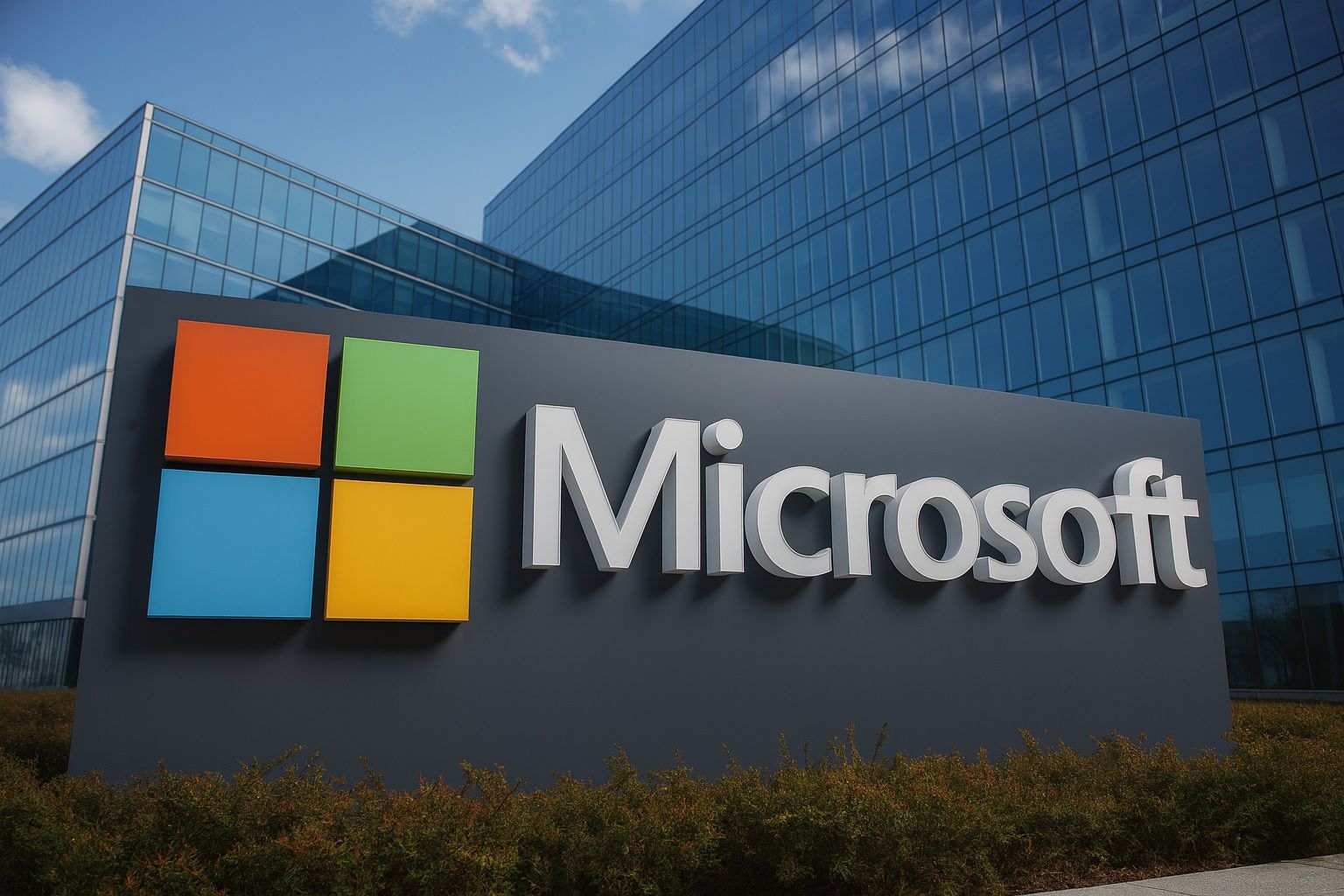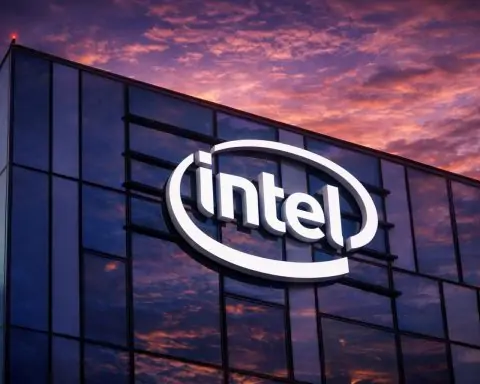- Stock near record highs: Microsoft shares are hovering around historic peaks in late October 2025, recently closing about $514 by mid-month – just shy of the all-time high (around $555) – lifting its market cap to roughly $3.8 trillion [1]. The stock is up approximately 25% year-to-date, far outpacing the broader market amid excitement over AI and cloud growth.
- Analysts overwhelmingly bullish: 32 of 34 Wall Street analysts rate MSFT a “Buy,” with 12-month price targets averaging about $618 (around 20% above current levels) [2]. Top bullish forecasts even see $650–$710 ahead, and Wedbush’s Dan Ives projects Microsoft could reach a $5 trillion valuation as its AI initiatives scale [3].
- AI & cloud mega-investments: Microsoft doubled down on AI infrastructure in October, investing billions to secure computing power. It struck a 5-year, $17.4 billion supercomputer deal with Nebius to access over 100,000 Nvidia GPUs [4], and joined a Nvidia/BlackRock-led group to acquire Aligned Data Centers for about $40 billion [5] – one of the largest data-center deals ever – to expand capacity for AI workloads.
- New products and AI features: At Dubai’s GITEX tech expo in mid-October, Microsoft unveiled AI-enhanced Surface “Copilot+” PCs and its first 5G-enabled Surface Laptop, showcasing on-device Copilot AI capabilities for business users [6]. It also announced Microsoft 365 Copilot will ingest 33 petabytes of London Stock Exchange market data via a new partnership [7], and launched local Copilot cloud hosting in the UAE to meet regional data rules [8]. Just days ago, Microsoft introduced new Copilot features – including collaborative capabilities and deeper integration with Google services – and even a new AI avatar called “Mico” to make conversations feel more natural [9] [10].
- Leadership shifts for AI era: CEO Satya Nadella reorganized Microsoft’s top ranks on Oct. 1 to accelerate AI innovation. Longtime executive Judson Althoff was promoted to CEO of the massive commercial business (~75% of revenue), freeing Nadella to focus on “datacenter buildout, systems architecture, AI science, and product innovation” amid what he calls a “tectonic AI platform shift” [11]. Nadella told employees Microsoft must “build the new frontier” in AI while continuing to grow its core businesses [12].
- Financial momentum & earnings: Microsoft’s financial momentum remains strong. In its last quarter (FY2025 Q4, ended June), revenue jumped 18% to $76.4 billion and earnings beat estimates [13], with Azure cloud revenue surging +34% year-over-year [14]. The company will report fiscal Q1 2026 earnings on Oct. 29, and analysts expect another robust quarter (around $75–76 billion in revenue and ~$3.65 EPS) [15]. Investors are watching whether Azure’s growth stays hot and how heavy AI investments – CFO Amy Hood signaled record capital spending of nearly $30 billion this quarter – could impact profit margins [16].
- Regulatory and legal updates: Microsoft navigated key regulatory developments this month. In Europe, antitrust regulators accepted its plan to unbundle Teams from Office 365 (with discounted pricing) to resolve an EU competition probe [17]. In the U.S., however, a new class-action lawsuit claims Microsoft’s exclusive OpenAI partnership is anti-competitive – an allegation Microsoft disputes [18]. Meanwhile, Windows 10 officially reached end-of-life on Oct. 14, 2025, ending free security updates for millions of remaining users (Microsoft is offering a one-year extended support to ease the transition) [19].
- Upbeat investor sentiment: Market sentiment remains positive on Microsoft as a prime beneficiary of the AI revolution. “Microsoft is becoming more of a cloud infrastructure business and a leader in enterprise AI,” observes Gerrit Smit of Stonehage Fleming [20]. The company’s fundamentals – robust cash flows, high margins, and double-digit growth – bolster the bull case [21]. While some warn that AI hype has driven valuations high (forward P/E near 28×) and any growth stumble could spark a pullback [22], for now “the bulls remain fully in charge,” one strategist noted, thanks in part to cooling interest rates providing a “notable macro tailwind” for tech stocks [23].
Stock Performance and Market Snapshot (Late October 2025)
Microsoft’s stock has been on a tear through 2025, and the rally continued into late October. On Friday, October 24, MSFT shares closed around $523–524, essentially at record-high territory [24]. That’s just a few percentage points below the stock’s all-time closing high (approximately $535) and near the intraday peak (~$555) reached over the summer [25]. Year-to-date, Microsoft has gained roughly 25%, adding hundreds of billions in market value and cementing itself as one of the world’s most valuable companies at about $3.8 trillion market cap [26]. For context, the S&P 500 is up only single digits this year, so Microsoft’s run has significantly outpaced the broader market.
Notably, Microsoft’s stock found strong support around the $500–$510 level during early October and then pushed higher [27]. By mid-month it was flirting with record highs, briefly touching about $524 around Oct. 22 [28]. Technical analysts have pointed out that ~$520 was a near-term resistance level, so a decisive break above that range puts Microsoft in position to challenge new all-time highs. Indeed, a bullish breakout could quickly send MSFT into the mid-$500s (its previous peak zone), with some eyeing $575 or even $600 as psychological upside targets if momentum continues [29]. Importantly, market indicators show the rally has not yet entered “overbought” extremes – e.g. Microsoft’s Relative Strength Index (RSI) has been in a healthy mid-50s range – suggesting the uptrend “has some gas left in the tank,” as TS2.tech noted [30] [31].
Broader market conditions have also provided a tailwind. U.S. equity indices hit fresh highs in early October amid cooling inflation and expectations that the Federal Reserve will ease interest rates after a long hiking cycle [32]. Lower rates make future earnings more valuable, which tends to boost rich-valued growth stocks. This macro shift has improved sentiment for Big Tech across the board [33]. As one strategist put it, “the bulls remain fully in charge” with a more dovish Fed, creating a favorable backdrop for tech leaders like Microsoft [34] [35]. In short, investors have been willing to “buy on dips” given Microsoft’s strong fundamentals and the supportive economic outlook [36]. Barring any unforeseen shocks, Microsoft appears poised to finish 2025 on a high note [37].
Growth Drivers: Cloud, AI… and Even Cybersecurity
The enthusiasm around MSFT is underpinned by robust financial growth and leadership in key tech trends. In its fiscal year 2025 (ended June), Microsoft’s revenue jumped 15% to $281.7 billion, with operating income up 17% [38] [39]. The Intelligent Cloud division (anchored by Azure) led the way, but broad-based gains were seen across productivity software and personal computing as well. Notably, Azure – Microsoft’s cloud computing platform – has been a powerhouse: in the latest quarter Azure revenue climbed 39% year-over-year [40], an acceleration as businesses worldwide ramp up spending on AI and digital transformation. That growth dwarfed rivals – Amazon’s AWS grew ~17% and Google Cloud ~32% in the same period [41] [42] – indicating Microsoft is gaining cloud market share and establishing itself as a frontrunner in the AI-powered cloud era. CEO Satya Nadella highlighted that Microsoft’s total cloud revenue (across Azure, Office 365, Dynamics, etc.) hit a staggering $168 billion annual run-rate in FY2025 [43].
Importantly, Microsoft’s success isn’t limited to cloud infrastructure. The company has a diversified tech empire – and many of those pieces are thriving. For example, Office 365 and other productivity tools continue to grow in the mid-teens percentage range [44] as enterprises adopt AI-enhanced features. LinkedIn saw record engagement and a 9% revenue uplift [45]. Even the “More Personal Computing” segment, which includes Windows, Surface devices, and Xbox gaming, delivered growth last quarter. Windows OEM sales have rebounded as companies refresh PCs (especially with Windows 10 support ending this month), and Microsoft’s gaming division – now bolstered by the $69B Activision Blizzard acquisition – posted a 13% jump in Xbox content and services revenue [46]. (Microsoft revealed that its Game Pass subscription service now exceeds 50 million users, and it plans to bring popular Activision titles to Game Pass to drive further growth [47].) All told, Microsoft is “firing on multiple cylinders” with momentum in cloud, productivity software, and gaming alike [48] [49]. This multi-faceted strength gives investors confidence that Microsoft’s earnings engine has depth beyond just one hot trend.
One often overlooked contributor is Microsoft’s burgeoning cybersecurity business. With cyber threats escalating in the AI era, Microsoft has quietly become one of the world’s largest security vendors. In fiscal 2025, the company generated roughly $37 billion in security-related revenue – about 14% of its total revenue [50]. To put that in perspective, Microsoft’s security segment alone is several times larger than leading pure-play cybersecurity firms (CrowdStrike’s annual revenue is ~$4 billion; Palo Alto Networks’ is ~$10 billion) [51]. Microsoft bundles advanced security features into its cloud and software offerings – from Azure’s identity management to Defender antivirus in Windows – giving it a unique integrated security platform [52]. This not only adds a hefty, recurring revenue stream but also makes Microsoft’s ecosystem stickier for customers who appreciate an all-in-one solution. As generative AI raises the stakes in cybersecurity (both as a tool for defense and a weapon for attackers [53]), Microsoft’s end-to-end scale in security is increasingly seen as a strategic advantage. In fact, analysts call cybersecurity Microsoft’s “underappreciated third pillar” (alongside cloud and AI) supporting its premium valuation [54] [55].
Major News and Developments Driving MSFT
Microsoft’s recent rally has been fueled by a flurry of news and initiatives that underscore its aggressive push into AI – and its ability to execute on that vision. Among the most significant developments:
- Big Bets on AI Infrastructure: Microsoft is spending unprecedented sums to ensure it has the raw computing horsepower for the AI age. In late September (spilling into October news), Microsoft inked a 5-year, $17.4 billioncontract with Nebius Group to provide Azure with dedicated GPU supercomputing capacity [56]. This deal secures access to over 100,000 Nvidia chips hosted in Nebius’s data centers, and can expand to $19.4 B if Microsoft needs more [57]. Analysts note the partnership helps Microsoft bypass potential GPU shortages – essentially “outsourcing” some AI capacity so Azure isn’t bottlenecked by the industry-wide chip crunch [58] [59]. Then in mid-October, Microsoft joined forces with chip-maker Nvidia and asset manager BlackRock in a consortium to acquire Aligned Data Centers for about $40 billion [60]. Aligned operates dozens of data centers, and this blockbuster acquisition (one of the largest ever in that industry) is aimed squarely at expanding infrastructure for cloud and AI services [61] [62]. “With this investment in Aligned…we further our goal of delivering the infrastructure necessary to power the future of AI,” said BlackRock CEO Larry Fink of the deal [63] [64]. Microsoft’s involvement shows it is willing to literally buy the cloud capacity needed to keep expanding Azure and Copilot AI. In fact, the company reportedly plans to spend $80 billion on AI data centers globally over the next several years [65] – a staggering commitment – half of which will be in the U.S. For Microsoft, these bets are about entrenching itself as the go-to platform for AI, even if it means short-term expenses.
- New AI-Powered Products: Microsoft also rolled out attention-grabbing products that blend hardware and AI software. At the GITEX technology expo (Oct. 15) in Dubai, the company unveiled the Surface Copilot+ line of PCs – including its first-ever 5G-enabled Surface Laptop [66]. These new Surface devices come with built-in AI Copilot features, leveraging on-device neural chips to handle AI tasks. The launch demonstrates Microsoft’s ambition to bring AI capabilities to everyday business laptops, positioning its hardware for an era of AI-assisted productivity. Meanwhile, Microsoft’s flagship software is getting more intelligent. The company announced that Microsoft 365 Copilot (its AI assistant for Office apps) will be supercharged with financial market data through a partnership with the London Stock Exchange Group (LSEG) [67]. LSEG will provide 33 petabytes of proprietary market data to Microsoft’s AI, allowing Copilot to help analysts and investors with real-time insights – a powerful use-case for AI in finance [68] [69]. In addition, Microsoft began offering localized AI cloud services in new regions: for example, it is now enabling Microsoft 365 Copilot to be hosted in UAE data centers, so Middle Eastern customers can use AI tools while keeping their data within national borders [70] [71]. This move addresses data sovereignty concerns and could speed Copilot’s adoption by governments and regulated industries.
- Copilot Evolves: On the consumer and software front, Microsoft is continuously updating its AI Copilot assistant to stay ahead of rivals. Just this past week (Oct. 23), Microsoft introduced a slate of new Copilot features across Windows and Bing. The AI assistant will now support “Copilot Groups” – allowing up to 32 people to collaborate with an AI in a shared workspace – and it can integrate more deeply with third-party apps and even Google services like Gmail and Google Sheets [72]. Perhaps most buzzworthy, Microsoft gave Copilot a face of sorts: a new animated avatar named “Mico” (short for Microsoft Copilot) that can display facial expressions and change colors during chats [73]. The company says this avatar makes AI interactions feel more natural and human-like. All these updates are aimed at keeping Microsoft’s AI offerings at the cutting edge as competition intensifies – Alphabet’s Google, OpenAI’s ChatGPT, and others are rapidly advancing their own AI assistants [74] [75]. By beefing up Copilot’s capabilities and user-friendliness, Microsoft hopes to drive even greater adoption of its AI ecosystem across Windows, Office, and the web.
- Xbox Goes Premium: Beyond enterprise software, Microsoft made waves in gaming this month with bold hardware moves. Its Xbox division announced a $999 handheld gaming device called the “Xbox Ally X,”essentially a mini Windows 11 PC tailored for high-end portable play [76]. This price tag makes it the most expensive Xbox-branded product ever. Moreover, Xbox executives hinted that the next-gen Xbox console(expected in 2028) will be a “very premium, high-end” machine rather than a budget-friendly box [77]. Microsoft also raised prices on current Xbox hardware (the flagship Xbox Series X now costs $649) and on Game Pass subscriptions, moves that sparked some backlash from gamers on social media [78] [79]. The company defended the strategy, arguing that investing in cutting-edge hardware (in partnership with AMD for custom chips) will pay off with a superior experience for enthusiasts [80] [81]. While the gaming news didn’t move MSFT stock in the same way that AI news did, it shows Microsoft’s broader game plan: in every segment – from cloud data centers to consumer gadgets – Microsoft is aiming for top-tier offerings that can command premium pricing and loyalty, rather than competing on lowest cost. Investors generally applaud this focus on value-add and innovation, as it aligns with Microsoft’s strong profit margins and brand strength (even if some price-sensitive consumers balk).
- Strategic Partnerships: Microsoft has also been busy inking partnerships to extend its reach. In early October, it announced a deal with fintech firm Checkout.com, integrating Azure’s AI services into digital payment platforms [82] [83]. This kind of partnership opens new avenues for Azure in the financial technology sector. And looking abroad, Microsoft’s multi-year collaboration with OpenAI (maker of ChatGPT) continues to evolve – reports suggest Microsoft is now working with OpenAI on new AI chips and perhaps a broader commercialization strategy, showing the partnership remains deep [84]. (Notably, there were rumors this fall about potential tensions as OpenAI expands its own offerings, but Microsoft has an exclusive license on GPT-4 and heavy investment in OpenAI, aligning their interests.) All these alliances – whether with data providers, industry-focused startups, or AI research labs – aim to ensure Microsoft’s platform has unique capabilities and content to offer its customers.
In sum, Microsoft spent October launching products, cutting deals, and investing in infrastructure at a breakneck pace. This constant stream of positive news has helped propel MSFT shares upward. Each announcement – be it a major GPU deal or a flashy new AI feature – reinforces the narrative that Microsoft is leading the pack in the AI era and aggressively investing to maintain that lead. As a result, investors have been quick to bid the stock higher on any signs that Microsoft’s AI strategy is translating into tangible growth opportunities.
Upcoming Earnings and Catalysts
The next major catalyst on the calendar is Microsoft’s earnings report for the July–September quarter (Q1 of fiscal 2026), which is scheduled for Wednesday, Oct. 29 after market close [85]. Given the stock’s recent run, all eyes on Wall Street will be watching to see if Microsoft’s results and outlook justify the optimism. Analysts expect strong numbers – consensus forecasts call for around $75–76 billion in revenue (approximately 10–12% growth year-on-year) and earnings per share of about $3.65–3.68 [86]. Microsoft has a track record of beating estimates (last quarter’s $3.65 EPS handily beat the ~$3.35 expected [87]), so investors will be looking for signs of continued double-digit growth.
Beyond the headline numbers, the key metrics and commentary will be crucial. In particular, traders and analysts will scrutinize:
- Azure and AI Demand: Cloud growth remains the linchpin. Any update on Azure’s revenue growth rate will be parsed closely. If Azure is still growing near ~35–40% (as it did last quarter) it would affirm that enterprise demand for cloud and AI services is still red-hot. Moreover, Microsoft’s management might share early indications of Copilot adoption. Since launching its AI Copilot for Office apps and Windows, Microsoft has been marketing it heavily to enterprise customers (at $30 per user per month). A recent Motley Fool analysis noted investors will “keep an eye on Copilot adoption” as a gauge of how much revenue uplift Microsoft’s AI features might generate [88]. Encouragingly, there are signs of big-customer interest – for instance, Barclays reportedly purchased 100,000 Microsoft 365 Copilot licenses in a trial, hinting that large enterprises are testing the waters of AI productivity tools [89]. Any concrete stats or anecdotes from Microsoft about Copilot usage could further excite investors about a new high-margin revenue stream.
- Profit Margins and Spending: A big question is how Microsoft’s massive AI investments are impacting its bottom line in the near term. CFO Amy Hood has already warned that capital expenditures in the current quarter will spike to “record” levels (around $30 billion) due to investments in data centers and chips for AI [90]. That’s an eye-popping sum even for Microsoft, and it could weigh on free cash flow and operating margins temporarily. Investors will want to know if this spending surge is a short-term blip or the start of a new normal. Microsoft will likely emphasize that these costs – though huge – are necessary to meet booming demand and will pay off long-term via higher capacity. Any guidance on profit margins for coming quarters will be closely watched. If Microsoft can fund its AI expansion while keeping margins relatively healthy, it will reassure investors. Conversely, if management indicates margins will be crimped for a while, some analysts might trim earnings forecasts.
- Outlook & Guidance: Perhaps most importantly, Microsoft’s forward-looking commentary could move the stock. This earnings call will be the first where CEO Satya Nadella and team provide guidance well into 2026, taking into account all the recent AI product launches. Observers expect Nadella to sound upbeat about AI demand (he has called this the start of a “tectonic” platform shift). But any notes of caution – e.g. signs that some customers are slowing cloud spending or that AI uptake is gradual – would be notable. Thus far, Microsoft’s tone has been optimistic; the company said in July that AI interest was translating into real Azure consumption. If they reiterate that trend and maybe hike their outlook, the stock could get another boost. On the flip side, if Azure’s growth is guided to decelerate or if economic concerns are mentioned, it could give the market pause [91] [92] given Microsoft’s high valuation. Additionally, analysts will likely ask about the competitive landscape (Google just rolled out new AI tools, AWS is investing in its own AI chips, etc.) and about any signs of regulatory risk (for example, the new antitrust lawsuit regarding OpenAI). Microsoft’s responses to these questions will help shape the narrative for the coming months.
In short, the Oct. 29 earnings report is a major inflection point. A strong report with confident guidance could validate the stock’s recent run and potentially push MSFT to new heights. However, any disappointments or cautious signals might spur a pullback, at least in the immediate aftermath, considering the stock “is priced for a lot of good news”already [93]. The earnings also come amid a big week for Big Tech generally – fellow “Magnificent 7” giants Alphabet (Google), Amazon, Apple, and Meta are all reporting around the same time. Surprises (good or bad) from those peers could spill over to affect Microsoft’s stock as well [94] [95], given broader market sentiment. Investors are thus gearing up for a potentially volatile stretch as the market digests a deluge of tech earnings. So far, though, sentiment on Microsoft remains bright heading in.
Wall Street’s View: “Overwhelmingly Positive”
Despite Microsoft’s hefty market cap, Wall Street analysts largely agree that there is more upside ahead. The stock has near-unanimous support from the analyst community. According to MarketBeat data, 32 out of 34 analysts covering MSFT rate it a “Buy”, and there are zero “Sell” ratings [96] [97]. Such a consensus is rare for a company of Microsoft’s size, indicating a strong conviction that Microsoft will continue executing well. The median 12-month price target is around $620–630 per share [98] [99], roughly 15–20% above the current stock price. Price targets cluster in the low-$600s, but some bulls go much further – several prominent analysts have targets in the mid-$600s or higher [100]. For example, UBS recently reiterated a $650 target (on October 22) after observing accelerating Azure growth [101]. Bank of America is at $640, predicting Azure will expand ~39% and noting upside from AI-driven cloud demand [102]. Morgan Stanley has cited Microsoft’s “outstanding” cloud performance in raising its target to $625, while Morgan Stanley’s bullish case scenario is reportedly $700+ if AI adoption surprises to the upside [103] [104]. Perhaps most eye-catching, Wedbush Securities’ well-known tech analyst Dan Ives has argued Microsoft is on a path toward a $5 trillion market valuation (from ~$3.8 T now) in the next couple of years, as its AI endeavors scale up and drive new growth [105] [106]. Achieving $5 trillion would imply a stock price north of $660–670. Ives and others see Microsoft as a cornerstone of the “AI gold rush” and believe we are still in the early innings of that cycle [107] [108].
What’s driving this enthusiasm from analysts? In their research notes, several themes emerge: 1) Microsoft’s leadership in cloud and AI positions it to capture a disproportionate share of tech spending in coming years; 2) The company’s execution has been consistently strong, with a history of earnings beats and effective cost management by CFO Amy Hood; 3) Microsoft’s revenue streams are increasingly recurring (think subscription software, Azure usage, etc.) and diversified, which provides resilience; 4) Compared to other mega-caps, Microsoft is seen as having one of the clearest paths to maintain double-digit growth for a multi-year stretch, thanks to AI. As TS2.tech summarized, Microsoft is viewed as the “winner of the AI revolution,” with a broad product mix that provides a buffer against any single market risk [109]. This sentiment is echoed by many fund managers – for instance, Gerrit Smit of Stonehage Fleming (quoted earlier) highlights Microsoft’s transformation into a dominant cloud and enterprise AI player [110].
Even typically cautious investors have warmed up to Microsoft. The company’s dependable cash flows (over $70 billion in annual free cash flow) and massive cash reserves give it ballast in uncertain times. It also pays a dividend (recently raised by 10% in September) and continues to buy back shares, which appeals to long-term “value” oriented holders. Some analysts note that by traditional metrics Microsoft’s stock is expensive – trading around 28× forward earnings, a premium to the market [111] – but most argue that premium is justified by the growth trajectory and Microsoft’s dominant competitive moat [112] [113]. In fact, as long as Microsoft delivers ~15%+ earnings growth, that multiple is expected to come down over time.
Of course, not everyone on the Street is pounding the table unabatedly – there are a few concerns in the mix. A common caution is valuation: if the broader market stumbles or if interest rates rise again, high-multiple stocks like MSFT could see sharper pullbacks. Additionally, while no major analyst is outright bearish, some have noted that Microsoft’s AI narrative now carries very high expectations. Any sign of Azure growth deceleration or slower uptake of pricey AI services might cause the stock to consolidate or trade sideways as investors digest the news. There’s also the question of competition: Google and Amazon are investing heavily to close the gap in cloud, and open-source AI could eventually challenge proprietary models like OpenAI’s. Microsoft will need to continually prove it can defend its turf. Lastly, regulators around the world are increasingly scrutinizing Big Tech. Microsoft mostly avoided the recent antitrust limelight (compared to Google or Amazon), but any new regulatory roadblocks – whether antitrust actions or AI oversight – could pose a risk to its unfettered growth [114].
On balance, however, Wall Street’s tone is optimistic. The sheer unanimity of “Buy” ratings is striking. As one market column noted, it’s “an almost unprecedented level of agreement” on a $3+ trillion company. That doesn’t guarantee performance, but it indicates that professional analysts, armed with channel checks and models, largely see positive risk-reward in Microsoft at current levels. Microsoft was even recently highlighted in screens for Warren Buffett-style value (despite its growth stock label) because of its stable returns on capital and fortress balance sheet [115]. In other words, Microsoft is managing to appeal to both growth investors and more conservative investors – a rare feat – thanks to its unique position in the tech ecosystem.
Tech Sector Trends Shaping Microsoft’s Future
Microsoft’s trajectory is deeply intertwined with several broader tech trends that are reshaping the industry. Chief among them:
- Artificial Intelligence: AI is the central theme of Microsoft’s story in 2025. The company’s bold strategy – investing in AI at every layer (infrastructure, platforms, applications) – aligns with a secular shift across the economy toward AI-driven productivity. Corporate spending on AI is projected to grow at a compound 20–30%rate in coming years, and Microsoft is positioned to capture this through Azure’s AI services, Azure OpenAI offerings, and AI features in its software lineup. Satya Nadella often compares the significance of AI today to the rise of the internet or mobile computing in past decades [116] [117]. Microsoft’s massive bet on OpenAI (and the integration of GPT-4 into Bing and Office) reflects its determination not to miss this paradigm shift. The market’s repricing of MSFT in 2023–2025 (adding trillions in cap) is largely a reflection of the AI premium – investors believe Microsoft will be one of the primary winners as AI spending explodes. However, AI is also an area of intense competition: Google is infusing AI across search and cloud, Amazon is targeting AI developers with AWS offerings, and startups are innovating rapidly. Microsoft will need to keep its foot on the gas to maintain leadership. On the AI safety/regulation front, governments are starting to consider rules for generative AI (an EU AI Act is in draft, for example). Microsoft’s close partnership with OpenAI could bring both upside (first access to breakthroughs) and scrutiny (if issues like AI bias or copyright arise). So far, Microsoft has navigated this well, positioning itself as a responsible AI leader (it has an Office of AI Ethics and emphasizes transparency). In summary, AI remains the biggest opportunity – and a manageable risk – for Microsoft’s next decade.
- Cloud Computing: The ongoing migration to cloud computing is another robust tailwind. Even after years of growth, only an estimated ~30% of enterprise workloads are on public clouds, leaving plenty of runway. Microsoft’s Azure is benefitting not only from new cloud adoption but also from multi-cloud trends (companies splitting work between AWS, Azure, etc.) where Microsoft often wins due to its enterprise relationships and hybrid cloud offerings. Azure’s growth outpacing AWS and Google Cloud recently [118] suggests share gains that could continue. Moreover, Microsoft’s cloud is increasingly differentiated by platform services (databases, AI/ML frameworks, analytics) on top of basic infrastructure. By embedding AI (like Copilot and cognitive services) into Azure, Microsoft is turning cloud into more than a commodity – it’s an AI-enabled cloud platform. One emergent area is industry-specific cloud solutions (Microsoft has clouds for healthcare, finance, etc.). These play to Microsoft’s strengths in sales and partnerships. A potential challenge in cloud is pricing/margins: as it scales, Azure’s operating margins are healthy but somewhat lower than software margins, and the AI boom requires heavy investment (as seen with those GPU purchases). Still, cloud computing as a trend is firmly in Microsoft’s favor. Analysts estimate Azure could surpass AWS in revenue within a few years if current growth differentials persist [119] [120].
- Cybersecurity: As discussed, cybersecurity is a growing concern for all businesses – and the rise of AI has two sides for security. AI helps improve cyber defenses (Microsoft uses AI to analyze 65 trillion threat signals daily across its ecosystem [121] [122]), but AI can also empower more sophisticated cyberattacks. This dynamic is forcing companies to spend more on security tools and services, creating a tailwind for Microsoft’s security offerings. Microsoft’s approach of integrating security into its cloud and software products (rather than selling standalone appliances like legacy vendors) is resonating with customers who prefer a unified solution [123]. For instance, Microsoft Defender, Sentinel, and Entra (identity management) all tie into Azure’s cloud SIEM and AI analytics, giving CISOs a one-stop-shop. This integrated model is making Microsoft a formidable competitor to the likes of Palo Alto, CrowdStrike, and Zscaler. Industry analysts expect Microsoft’s security revenue to keep growing in high-teens percentages, potentially surpassing $50 billion by 2030 [124] [125]. One risk in security is that threats evolve quickly, so Microsoft must remain nimble (it sometimes faces criticism for being slow to patch vulnerabilities – the recent Exchange server issues, for example). Nonetheless, the AI-cybersecurity nexus is one where Microsoft has a strong story: it can claim that its AI not only boosts productivity but also safeguards users, a message likely to drive further enterprise adoption.
- Hardware and Chips: Microsoft historically is a software-first company, but trends in hardware are impacting it too. The global PC market has stabilized after a post-pandemic slump, aided by the Windows 10 end-of-life forcing upgrades. This has provided a nice bump to Windows OEM revenues and Surface device sales (Windows 11 adoption is picking up). Looking ahead, Microsoft is working closely with chip partners like AMD and Qualcomm on AI-optimized chips for PCs and servers. There’s talk that the next Surface devices and even future Xbox could use custom AI silicon, similar to how Apple designs its own chips. In the data center, Microsoft is reportedly developing its own AI chips (code-named “Athena”) to reduce reliance on Nvidia – a trend of vertical integration we see in other cloud players too. If Microsoft succeeds, it could lower its AI cloud costs and better tune hardware for its needs. However, chip design is expensive and tricky, so it’s a space to watch. Meanwhile, Microsoft’s foray into devices (Surface, Xbox, HoloLens) is strategic – these products aren’t the main profit drivers, but they ensure Microsoft stays in the hardware loop, which is important as computing becomes more ubiquitous (think AR/VR, IoT, etc.). The recent premium Xbox strategy suggests Microsoft is focusing on margin and ecosystem (Game Pass) over pure console unit sales, which aligns with a broader trend: tech giants are fine selling fewer devices if each customer is more deeply engaged (and profitable).
Overall, the tech trends of AI, cloud, and security are all synergistic for Microsoft. The company’s ability to offer an end-to-end stack – from cloud infrastructure and AI software to the very endpoint devices people use – gives it a compelling strategic position. This “full stack” approach is something only a few companies (perhaps Amazon and Google to some degree) can rival. It means Microsoft can capture value at multiple points and use one business unit to bolster another (e.g., selling Office 365 can pull through Azure usage and vice versa). As long as these secular trends continue on their current trajectory, Microsoft stands to benefit immensely.
Near-Term Outlook (1–6 Months)
In the next few months, Microsoft’s stock performance will likely be driven by its execution through the year-end and early 2026. Most analysts believe MSFT will maintain its positive momentum into the holiday season, albeit perhaps not as dramatically as in recent weeks. A key determinant will be the Q1 earnings and any guidance provided (discussed above). If Microsoft delivers a clean beat-and-raise – showing strong Azure growth and issuing confident forward guidance – it could catalyze another “leg higher” for the stock [126]. Many on Wall Street have set year-end 2025 targets for MSFT in the mid-$550s to low $600s, which implies moderate upside from current levels over the next 2+ months [127]. Hitting $560+ would mark a fresh record high. These targets assume that Microsoft continues to execute well and that tech sector conditions remain benign. For example, if the Federal Reserve indeed starts cutting rates in late 2025 (as the bond market anticipates), that could further boost high-valuation tech names like Microsoft by reducing the discount rate on future earnings [128] [129]. Microsoft would also likely benefit from any year-end “Santa Claus rally” in equities, as it’s a heavyweight in indexes.
That said, the near-term isn’t without potential volatility. With such a strong run behind it, MSFT could see bouts of profit-taking. Any hiccup in its earnings report or a guidance that merely meets (instead of beats) expectations might cause a short-term dip as traders reset their expectations. Additionally, macro news – such as economic data or geopolitical events – can sway the whole market and thus Microsoft. From a technical perspective, traders are watching the $520 level (which MSFT has just about cleared) as a new support; if the stock stays above that, it’s a sign of strength [130] [131]. On the upside, the previous record around $555 is the next resistance – crossing that decisively would be a bullish signal that could generate fresh momentum buying. It’s worth noting that many large-cap tech stocks historically see a bit of a year-end rally if earnings are solid, as fund managers window-dress portfolios with winners. Microsoft could fit that pattern this year. Barring any negative surprises, the consensus is that MSFT will “finish 2025 on a high note,” as TS2.tech puts it [132]. In summary, over the next 1–3 months, cautious optimism reigns: the path of least resistance for Microsoft’s stock appears upward, though perhaps at a more gradual pace, with the caveat that any sign of cloud demand cooling or macro hiccup could tap the brakes temporarily [133].
Longer-Term Outlook (6+ Months)
Looking further out into 2026 and beyond, the outlook for Microsoft remains decidedly positive according to industry experts – albeit with a few more unknowns simply due to the longer time horizon. Over the next 6–12 months, the average analyst sees Microsoft continuing to grind higher. The 12-month consensus price target in the low-$600s implies roughly 15–20% upside within the next year [134] [135]. If realized, that would put Microsoft’s market cap around $4.5–4.7 trillion by late 2026. The drivers for this growth are expected to be the same engines currently powering Microsoft: continued Azure/cloud expansion, monetization of AI across the product portfolio (Copilot subscriptions, Azure AI services, etc.), and steady growth in core franchises like Office 365, LinkedIn, and gaming. Importantly, much of Wall Street’s modeling assumes high-teens earnings growth for Microsoft for the next couple of years, which is extraordinary for a company of its size. As long as Microsoft can deliver that (or better), its stock will likely trend upward, perhaps not in a straight line but with an overall positive trajectory.
Bull-case scenarios: In more optimistic projections, some foresee Microsoft’s stock potentially approaching $700 in the next 1–2 years [136]. This would likely require a combination of factors: AI adoption accelerating faster than anticipated (e.g. a wave of enterprises opting for Copilot and other AI add-ons, creating a multi-billion dollar new revenue stream quickly), cloud growth re-accelerating or sustaining >30% for longer, and maybe a boost from macro factors like interest rates falling significantly (which would elevate valuations). In such a scenario, Microsoft’s market cap could indeed push toward $5 trillion. Wedbush’s Dan Ives has explicitly mentioned an 18-24 month view where Microsoft could be the first to hit that $5 trillion mark [137] [138], if AI-related revenue ramps up and the “AI gold rush” continues unabated. Another upside catalyst could be strategic M&A – Microsoft has shown it’s willing to make big acquisitions (LinkedIn in 2016, Activision Blizzard in 2022-23). If another transformative deal came along (for instance, something in AI or cloud services), it could boost long-term growth prospects, though regulators would scrutinize any mega-deal.
Bear-case scenarios: On the other hand, the longer term also has potential risks to consider. One concern is that the current AI euphoria across Big Tech could create a mini bubble that might deflate if the tech cycle turns or if AI adoption disappoints. If, say, companies prove slow to widely adopt AI assistants due to cost or security concerns, Microsoft’s revenue from those new offerings might come in below bullish estimates. Additionally, the cost side of AI – those huge capex bills – could weigh on profitability longer than expected, which might make some investors rethink paying a premium valuation. Regulatory threats are also more palpable in a multi-year view: the Department of Justice or FTC could decide to take a harder look at big cloud providers or app store practices (Microsoft has already made concessions in EU for Teams; one could imagine future scrutiny of Azure or Windows bundling, for example). There’s also the possibility of new competition emerging. Today, Microsoft’s main competitors are familiar names, but technology can surprise. It’s possible that an open-source AI platform or a new entrant could disrupt cloud/AI services in a way that forces Microsoft to react (some draw parallels to how open-source Linux challenged Microsoft’s Windows in servers decades ago – Microsoft eventually embraced open-source, but only after it became a force).
Moreover, hardware supply constraints (like an ongoing GPU shortage) could act as a governor on Microsoft’s AI growth [139]. If Nvidia and others cannot produce AI chips fast enough, Azure’s ability to sell AI capacity might be capped in the near term. Microsoft’s deals with Nebius and the push to develop its own chips are aimed at mitigating this, but it remains a factor. Geopolitical issues could also cast a shadow: Microsoft has a global presence and is exposed to risks like China–US tech tensions (which could affect its supply chain or market access) and conflicts that disrupt global IT spending.
That said, none of the foreseeable risks are seen as existential threats; rather, they are things that could slow Microsoft’s ascent, not stop it. The company’s entrenched position with enterprise customers (many of whom essentially run their operations on Microsoft software and cloud) gives it a degree of resilience. As one analyst put it, Microsoft “remains resilient with diversified businesses that can buffer the huge AI spend while positioning it for long-term growth” [140]. The sheer breadth of Microsoft’s product portfolio means that even if one area faces headwinds, another can pick up slack. For example, if PC sales weaken, the cloud division might carry the quarter, or if advertising revenue (Bing, LinkedIn ads) dips, perhaps enterprise software sales make up for it. This balance is a hallmark of Microsoft’s model nowadays, and it underpins many experts’ confidence in the long-term durability of its growth.
In quantitative terms, by the second half of 2026 and into 2027, many projections have Microsoft earning well over $20 per share annually (up from about ~$14 in FY2025). If achieved, even a market-multiple P/E would suggest a stock price in the high-$500s or $600s by that time. Microsoft’s own leadership seems optimistic: the company continues to invest for the future (for instance, building new data centers and AI research labs) at a pace that indicates they see enormous opportunity. Nadella and President Brad Smith have both recently stressed that we’re in “early days” of what AI will do, implying Microsoft is preparing for a decade-long transformation. The company’s recent shareholder letter and annual report emphasize themes of AI, cloud, and trust (security), aligning with the trends discussed above.
To sum up the longer-term picture: if Microsoft can maintain its current trajectory – leading in cloud and AI, steadily expanding in security and other services, and effectively managing costs – there is a strong case that MSFT stock will be higher 1–2 years from now. The exact magnitude is debateable (whether it’s 15% higher or 30% higher), but the consensus is that the direction is upward. As TS2.tech aptly noted, Microsoft is benefiting from “powerful trends in AI and cloud computing, delivering strong financial results, and enjoying a vote of confidence from both Wall Street and its own leadership” [141]. With those winds at its back, many are betting that the software giant’s best days are still ahead in the emerging AI age [142].
Sources: Key information and quotes were drawn from Microsoft’s official financial releases and investor materials [143] [144], recent news reports (e.g. Reuters on product announcements and regulatory developments [145] [146]), and expert analysis from financial media including TS2.tech (TechStock²) [147] [148]. These sources provide a well-rounded view of Microsoft’s stock performance, business moves, and the broader context in which the company is operating. Each citation above links to the original source for further reading and verification.
References
1. ts2.tech, 2. ts2.tech, 3. ts2.tech, 4. ts2.tech, 5. ts2.tech, 6. ts2.tech, 7. ts2.tech, 8. ts2.tech, 9. www.reuters.com, 10. www.reuters.com, 11. ts2.tech, 12. ts2.tech, 13. ts2.tech, 14. ts2.tech, 15. ts2.tech, 16. ts2.tech, 17. ts2.tech, 18. ts2.tech, 19. ts2.tech, 20. ts2.tech, 21. ts2.tech, 22. ts2.tech, 23. ts2.tech, 24. www.macrotrends.net, 25. ts2.tech, 26. ts2.tech, 27. ts2.tech, 28. ts2.tech, 29. ts2.tech, 30. ts2.tech, 31. ts2.tech, 32. ts2.tech, 33. ts2.tech, 34. ts2.tech, 35. ts2.tech, 36. ts2.tech, 37. ts2.tech, 38. ts2.tech, 39. ts2.tech, 40. ts2.tech, 41. ts2.tech, 42. ts2.tech, 43. ts2.tech, 44. ts2.tech, 45. ts2.tech, 46. ts2.tech, 47. ts2.tech, 48. ts2.tech, 49. ts2.tech, 50. www.investing.com, 51. www.investing.com, 52. www.investing.com, 53. www.investing.com, 54. www.investing.com, 55. www.investing.com, 56. ts2.tech, 57. ts2.tech, 58. ts2.tech, 59. ts2.tech, 60. ts2.tech, 61. ts2.tech, 62. ts2.tech, 63. ts2.tech, 64. ts2.tech, 65. ts2.tech, 66. ts2.tech, 67. ts2.tech, 68. ts2.tech, 69. ts2.tech, 70. ts2.tech, 71. ts2.tech, 72. www.reuters.com, 73. www.reuters.com, 74. www.reuters.com, 75. www.reuters.com, 76. ts2.tech, 77. ts2.tech, 78. ts2.tech, 79. ts2.tech, 80. ts2.tech, 81. ts2.tech, 82. ts2.tech, 83. ts2.tech, 84. www.reuters.com, 85. ts2.tech, 86. ts2.tech, 87. ts2.tech, 88. ts2.tech, 89. ts2.tech, 90. ts2.tech, 91. ts2.tech, 92. ts2.tech, 93. ts2.tech, 94. ts2.tech, 95. ts2.tech, 96. ts2.tech, 97. ts2.tech, 98. ts2.tech, 99. ts2.tech, 100. ts2.tech, 101. ts2.tech, 102. ts2.tech, 103. ts2.tech, 104. ts2.tech, 105. ts2.tech, 106. finance.yahoo.com, 107. www.geekwire.com, 108. www.geekwire.com, 109. ts2.tech, 110. ts2.tech, 111. ts2.tech, 112. ts2.tech, 113. ts2.tech, 114. ts2.tech, 115. ts2.tech, 116. ts2.tech, 117. ts2.tech, 118. ts2.tech, 119. ts2.tech, 120. ts2.tech, 121. www.investing.com, 122. www.investing.com, 123. www.investing.com, 124. www.investing.com, 125. www.investing.com, 126. ts2.tech, 127. ts2.tech, 128. ts2.tech, 129. ts2.tech, 130. ts2.tech, 131. ts2.tech, 132. ts2.tech, 133. ts2.tech, 134. ts2.tech, 135. ts2.tech, 136. ts2.tech, 137. www.geekwire.com, 138. www.geekwire.com, 139. ts2.tech, 140. ts2.tech, 141. ts2.tech, 142. ts2.tech, 143. ts2.tech, 144. ts2.tech, 145. www.reuters.com, 146. ts2.tech, 147. ts2.tech, 148. ts2.tech







